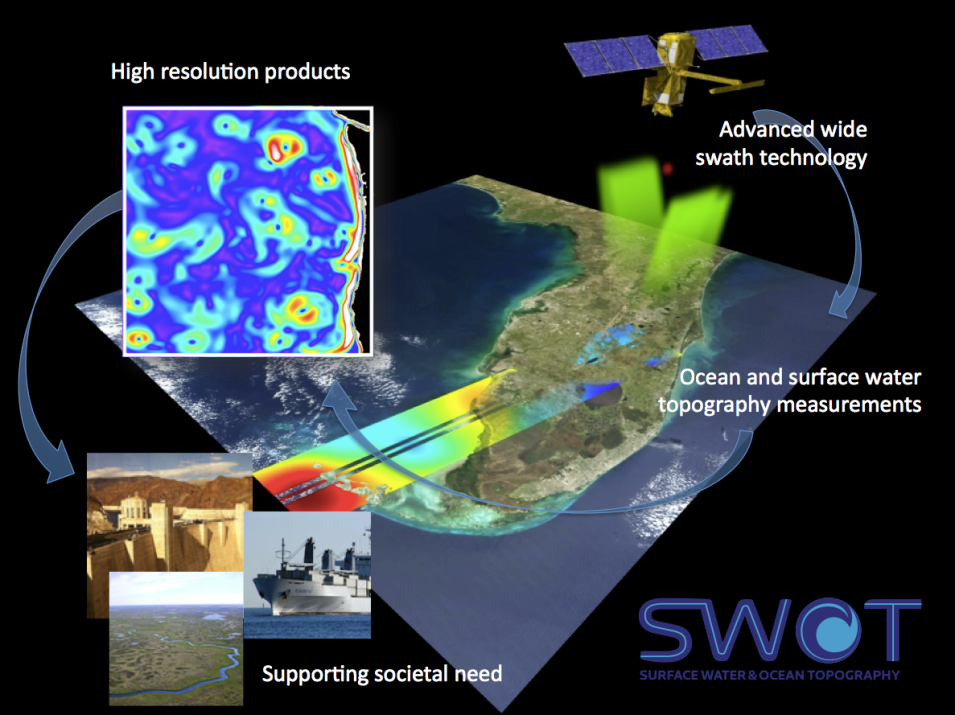What's new with SWOT is the novel Ka-Band Radar Interferometer that we often refer to as KaRIn. This new instrument provides measurements of water service elevation across a 120 kilometer (km) swath with significantly finer spatial resolution than the traditional nadir altimeters. One could think of it as a carpet 120 km-wide with a 20 km gap in the middle of it. The onboard nadir altimeter adds to that by providing point measurements in the middle of that gap, along the satellite ground track. So, the traditional altimetry missions only provide point measurements along the ground track whereas SWOT provides measurements spanning 120 km and with significantly better spatial resolution.
In addition to KaRIn, SWOT includes the traditional ocean altimetry suite of instruments, including a nadir altimeter like we have on Jason, a microwave radiometer, which measures the amount of water vapor between SWOT and Earth's surface, and tracking systems that enable accurate determination of the position of the satellite.
I want to ask about the calibration and validation phase for SWOT, but before I do, I’d like to discuss the calibration and validation of satellite instruments in general. What are the goals of calibration and validation?
Calibration and validation exercises are performed on each of the satellite's instruments. Further, calibration and validation happen through the life of a satellite mission.
Most, if not all, instruments require calibration to achieve and maintain measurement accuracy. Most often, this means determining the parameters that are applied during ground processing of the raw instrument data to provide accurate measurements for scientific use. Many of these calibrations are defined pre-launch as best as we can; however, this isn't always possible, mainly due to our inability to accurately represent the space environment. Some calibration parameters can change over time due to environmental effects, such as instrument temperature, as well as instrument aging.
Validation aims to provide us with the confidence that the measurements received after calibration are trustworthy, so we can have confidence in the resulting science or applications. The validation allows us to confirm that the calibrations are reliable and determine the accuracy of the resulting measurements from all of the instruments.
So, the reason calibration and validation are often linked together is because those activities are related, with one set of activities affecting the other.
Is there a standard or customary approach for conducting calibration and validation exercises—for example, comparing the measurements from instruments aboard a recently launched satellite with those from more mature sensors on other satellite missions, airborne campaigns, or ground networks—or are they developed specifically for each mission?
I don't know if this is always the approach, but from what you described it's generally similar. Calibration and validation involve using the in-flight measurements on their own, as well as comparing those in-flight measurements to measurements from other satellites or from measurements obtained from sensors on the ground or in the field.
The traditional altimetry missions have benefitted from almost three decades of heritage calibration and validation exercises, so in that sense, the concepts and methods for calibration and validation of those traditional altimeters are very well understood and the required infrastructure on the ground is mature and extensive. As experience grows with those altimeters and as technology advances, newer calibration and validation methods are often introduced. In the case of SWOT, because this new instrument—KaRIn—had never been flown in space, we really needed new calibration and validation activities.
How did SWOT's calibration phase differ from those of previous altimetry missions?
We needed to develop new methods, as the calibration and validation of SWOT's KaRIn instrument is particularly challenging for multiple reasons. For example, the size of the instrument itself and the measurement concept of that instrument made it especially difficult to completely calibrate pre-launch. So, we deferred determination of some of the calibration parameters until after launch out of necessity. Second, because KaRIn has no heritage, we had to plan on developing new methods to validate its measurements. And then third, KaRIn provides measurements across a 120 km [wide] swath, so the calibration and validation exercises had to be applied across the swath rather than at point-wise measurements along the satellite ground track.
So, yes, our SWOT field campaigns are different in terms of methodology for validation. Our field campaigns included the use of both airborne and field measurements, as well as comparison to measurements from other satellites. We had to develop novel methods to validate the significantly higher spatial resolution of the KaRIn measurements as compared to the nadir altimeters, as well as methods to validate across the swath instead of point measurements along the ground track. We developed comprehensive field campaigns for the ocean, rivers, and lakes.
For example, in one case we had an ocean campaign where we had a string of instruments along the ground track, which were spaced very close to each other. The goal there was to determine if KaRIn can provide measurements of the ocean at the expected spatial resolution. An airborne lidar was also flown over the same site both along and across the swath to validate the KaRIn measurements. On the hydrology side, we have campaigns of various rivers and lakes. We had boats towing GPS [Global Positioning System] buoys or instruments along the river that measured their height. We did similar exercises in lakes as well.
